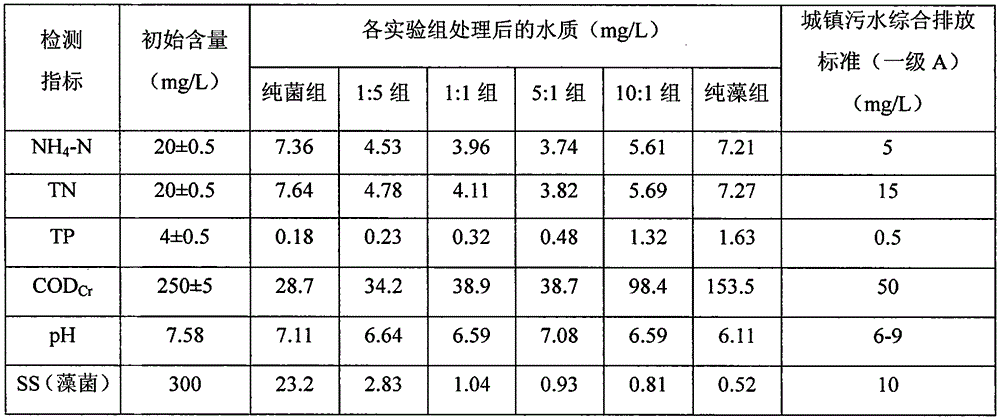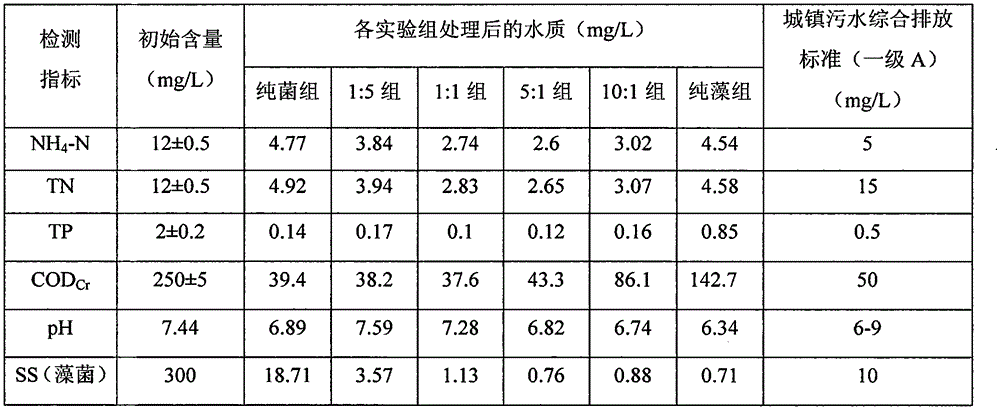Method for denitrogenation and phosphorus-removal of town sewage through efficient immobilized algae bacterial symbiosis system
A technology for the symbiosis of urban sewage and algae and bacteria, which is applied in chemical instruments and methods, biological water/sewage treatment, water/sludge/sewage treatment, etc. Dissolution and other problems, to achieve the effect of good engineering application prospects, easy implementation, and improved removal efficiency
- Summary
- Abstract
- Description
- Claims
- Application Information
AI Technical Summary
Problems solved by technology
Method used
Image
Examples
Embodiment 1
[0025] Water samples were taken from the secondary sedimentation tank of a sewage treatment plant, and the biological communities in the sewage were analyzed according to the polymerase chain reaction-denaturing gradient gel electrophoresis (PCR-DGGE) molecular biology method. The results showed that there were dominant algae in the sewage : Filamentous algae of the genus Coleopsis—Oedogonium brevicingulatum and Chlamydomonas asymmetrica.
[0026] Evaluation of the immobilization effect of the two kinds of algae: Take 4 2L beakers, fill each beaker with elastic three-dimensional filler, the volume filling rate of the filler is 60%, add 0.5g dry weight of breveenella to two of the beakers respectively , add 0.5g of Chlamydomonas asymmetrical dry mass in the other two beakers, add 1.5L tap water to each beaker, place the beaker in a shaker, control the water flow rate to 30-60cm / s, light intensity 4000lx, light and dark The time ratio is 12h:12h. After 24 hours, take out 1000ml ...
Embodiment 2
[0034] In this embodiment, the identification of dominant algae in the sewage, the screening of algal sources, the determination of the dry weight of algae and the setting of the experimental group are all the same as in Example 1. Each beaker is added with simulated sewage water quality NH 4 -N: 12±0.5mg / L, TP: 2±0.2mg / L, COD Cr : 250±5mg / L, pH: 7.44, water temperature: 25±5℃. After 3 days of treatment, the range of dry weight of algae: dry weight of bacteria in the experimental group was 1:5-5:1, and the NH in the treated simulated sewage 4 -N, TP, COD Cr , pH, and SS all meet the first-level A standard of the urban sewage treatment plant pollutant discharge standard (GB18918-2002).
[0035] The data comparison of the initial content of each substance in the above-mentioned embodiment, the water quality after the treatment of each experimental group and the pollutant discharge standard (GB18918-2002) of urban sewage treatment plants (GB18918-2002) is as follows:
[0036] ...
Embodiment 3
[0040] In this embodiment, the identification of dominant algae in the sewage, the screening of algae sources and the determination of the dry weight of algae are the same as in Example 1. The initial total biomass is controlled to 0.3g / L, and the dry weight of algae: the dry weight of bacteria is 1:5. , 1:1, 5:1 set up the experimental group, the volume filling rate of the elastic three-dimensional filler is 50% to 80%, the light intensity is controlled to 4000-6000lx, the light-to-dark time ratio is 12h:12h, and the influent of a sewage treatment plant is used as the experimental object , the whole process is magnetically stirred, and the rotor speed is controlled at the bottom of the beaker without algae and bacteria precipitation. After 2d treatment, NH in the experimental water 4 -N, TN, TP, COD Cr , pH, and SS all meet the first-level A standard of the urban sewage treatment plant pollutant discharge standard (GB18918-2002).
[0041] The data comparison of the waste wa...
PUM
 Login to View More
Login to View More Abstract
Description
Claims
Application Information
 Login to View More
Login to View More - R&D
- Intellectual Property
- Life Sciences
- Materials
- Tech Scout
- Unparalleled Data Quality
- Higher Quality Content
- 60% Fewer Hallucinations
Browse by: Latest US Patents, China's latest patents, Technical Efficacy Thesaurus, Application Domain, Technology Topic, Popular Technical Reports.
© 2025 PatSnap. All rights reserved.Legal|Privacy policy|Modern Slavery Act Transparency Statement|Sitemap|About US| Contact US: help@patsnap.com



